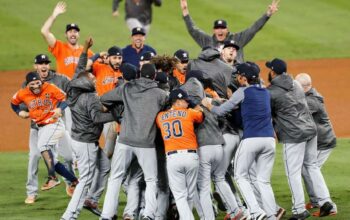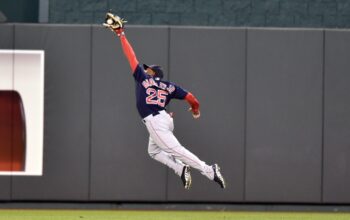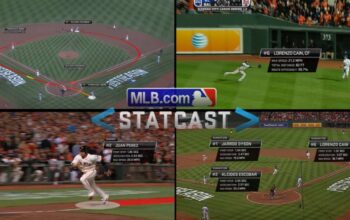As a lifelong New York Mets fan, I am accustomed to fast starts to the season in April and May followed by miserable slogs through summers of losing and giving up division leads. So, I know better than to get ahead of myself and declare the 2022 NYM the inevitable World Series Champions.
That being said, as every baseball fan does, forming quick and unbudging opinions of your favorite team is as much a part of America’s pastime as is the actual play on the field. So, let’s form an opinion of these New York Mets; starting with the offense.
Opinion #1: The New York Mets have a Top 3 run-scoring offense in the National League, helping to rocket this team to 29-17 start and 7.5-game lead over the tied-for-2nd Phillies and Braves in the NL East. The Mets offense has been buoyed by a MLB-leading 406 hits, at batting average that trails just the Rockies, an OBP less than only the Dodgers, and a team OPS+ 12% better than league average.
Opinion #2: The New York Mets have struggled to hit the ball hard all year, somehow surging to a 29-17 record that can only be explained with strong pitching and run prevention. The Mets have ridden bloop hits as they trail 26 other teams in Barrel percentage; also ranking towards the bottom of the league in Hard Hit percentage and Exit Velocity. If you want to find a column on Baseball Savant in which the Mets offense rank towards the top – check the Weak hit percentage.
Huh?
Neither opinion is wrong. At first instinct, it may be tempting to chalk up Opinion #1 to current-yet-unsustainable success with Opinion #2 as a gloomy precursor to some impending offensive slumping… but I’m not sure that is actually the case here.
See, the Mets are getting it done differently than other teams; and I’m not convinced that means it is unsustainable or destined for regression.
Let’s focus on two oft-overlooked offensive categories that Mets lead in: hit-by-pitch and infield hits. As a team, the Mets have 29 HBP and 76 infield hits (the next highest is the White Sox with only 56!); comparative to league averages of 17 and 43, respectively.
Well, how much do HBP and infield hits really affect offensive performance anyway? I’m glad you asked. Let’s look at it this way: if we converted 12 Mets’ HBP and 33 Mets’ infield hits into outs (a bit simplistic – I know), bringing each value down to league average… the Mets #2 MLB ranked OBP of .332 would drop all the way down to a below-league-average, #19 MLB-ranked OBP of .306! So yes, those HBP and infield hits matter!
Is it sustainable?
Well, it’s pretty well-established and widely accepted that HBP is, in fact, a repeatable skill. Just ask Craig Biggio about the 285 times he was plunked! In fact, the Mets have actually ranked towards the top of the leaderboards in this category for several years – leading the MLB as recently as 2019. Their lineup features several ball-magnet holdovers like Pete Alonso, Jeff McNeil, Brandon Nimmo, and JD Davis. On top of that, they imported guys with track records of high HBP numbers like Starling Marte and Mark Canha. I think it is safe to say, the Mets HBP numbers are far from fluky.
So, what about all those infield hits? As I touched on before – my first instinct is to assume infield hits are a function of luck; the product of (albeit well-placed) weakly-hit groundballs – a big no-no in the modern era of Statcast, Exit Velocity, and Launch Angle obsession.
A closer look might demonstrate that this might not be a fluke. Out of the Mets’ 76 infield hits, 50% of them are accounted for by just four players: Marte with 11, Nimmo 10, McNeil 9, and Canha with 8. Each of these guys rank in the Top 20 in MLB, which doesn’t really seem all that surprising. Each player profiles for this skill pretty well: gritty, hustle-types with good bat-to-ball skills and not a ton of power. McNeil’s bat-to-ball skills are astounding while Marte and Nimmo bring elite sprint speed to the dish. Let’s look at the numbers.
Marte stands out as the most compelling reason to believe accruing infield hits is a repeatable skill. He has spent most of his career near the top of the infield hits leaderboards – finishing in the Top 15 in 7 different seasons of his 9-year career.
McNeil has a fairly strong track record as well. Save for the 2021 season when nothing went his way, McNeil ranked 18th and 22nd in 2020 and 2019, respectively.
Nimmo has a spottier record of infield hits; however, he has only one season with over 386 plate appearances – perhaps, he just hasn’t had the opportunity to demonstrate his propensity for infield hits.
Canha’s performance this season provides the healthiest dose of skepticism. It is also worth noting that the Mets have played only 16 of their 46 games (35%) against above average team defenses (by either Defensive Runs Saved or Ultimate Zone Rating).
Fully-formed Opinion: Do I think the Mets have been a tad lucky to avoid teamwide slumping with such low hard-hit numbers? Perhaps. But I think there is plenty of reason to believe that their “get on base at all costs” method of taking one for the team or running out ground balls is perfectly sustainable. Maybe they won’t end up leading the league by such a wide margin in either category, but I see no reason to believe they are due for some harsh regression. In the meantime… LFGM!


